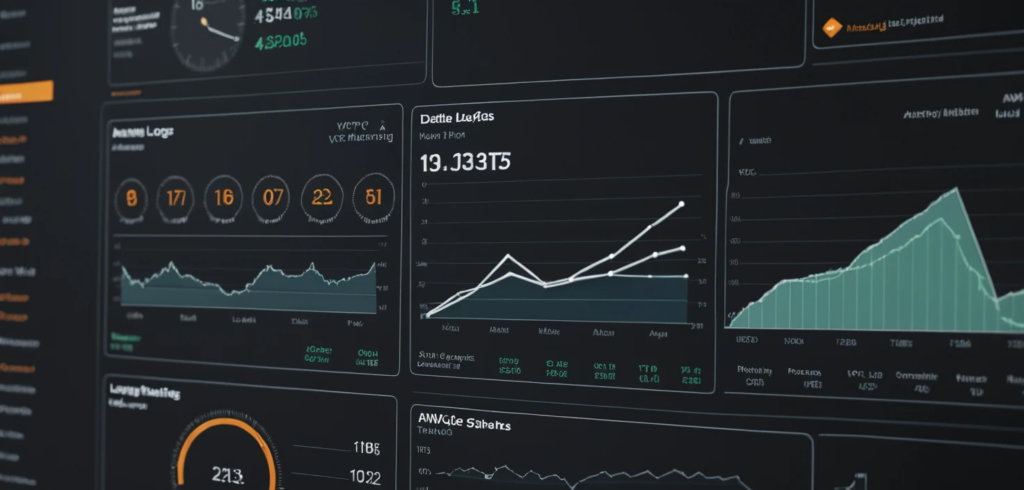
Managing cloud networks can often feel like navigating through dense fog. You’re in control of your applications and services, guiding them forward, yet the full picture of what’s happening on the network road ahead, particularly concerning security and performance, remains obscured. Without proper visibility, understanding the intricacies of your cloud network becomes a significant challenge.
Think about it: your cloud network is buzzing with activity. Data packets are constantly zipping around, like tiny digital messengers, carrying instructions and information. But how do you keep track of all this chatter? How do you know who’s talking to whom, what they’re saying, and if everything is running smoothly?
This is where VPC Flow Logs come to the rescue. Imagine them as your network’s trusty detectives, diligently taking notes on every conversation happening within your Amazon Virtual Private Cloud (VPC). They provide a detailed record of the network traffic flowing through your cloud environment, making them an indispensable tool for DevOps and cloud teams.
In this article, we’ll explore the world of VPC Flow Logs, exploring what they are, how to use them, and how they can help you become a master of your AWS network. Let’s get started and shed some light on your network’s hidden stories!
What are VPC Flow Logs?
Alright, so what exactly are VPC Flow Logs? Think of them as detailed записные книжки (notebooks – just adding a touch of fun!) for your network traffic. They capture information about the IP traffic going to and from network interfaces in your VPC.
But what kind of information? Well, they note down things like:
- Source and Destination IPs: Who’s sending the message and who’s receiving it?
- Ports: Which “doors” are being used for communication?
- Protocols: What language are they speaking (TCP, UDP)?
- Traffic Decision: Was the traffic accepted or rejected by your security rules?
It’s like having a super-detailed receipt for every network transaction. But why is this useful? Loads of reasons!
- Security Auditing: Want to know who’s been knocking on your network’s doors? Flow Logs can tell you, helping you spot suspicious activity.
- Performance Optimization: Is your application running slow? Flow Logs can help you pinpoint network bottlenecks and optimize traffic flow.
- Compliance: Need to prove you’re keeping a close eye on your network for regulatory reasons? Flow Logs provide the audit trail you need.
Now, there’s a little catch to be aware of, especially if you’re running a hybrid environment, mixing cloud and on-premises infrastructure. VPC Flow Logs are fantastic, but they only see what’s happening inside your AWS VPC. They don’t directly monitor your on-premises networks.
So, what do you do if you need visibility across both worlds? Don’t worry, there are clever workarounds:
- AWS Site-to-Site VPN + CloudWatch Logs: If you’re using AWS VPN to connect your on-premises network to AWS, you can monitor the traffic flowing through that VPN tunnel using CloudWatch Logs. It’s like having a special log just for the bridge connecting your two worlds.
- External Tools: Think of tools like Security Lake. It’s like a central hub that can gather logs from different environments, including on-premises and multiple clouds, giving you a unified view. Or, you could use open-source tools like Zeek or Suricata directly on your on-premises servers to monitor traffic there. These are like setting up your independent network detectives in your local office!
Configuring VPC Flow Logs
Ready to turn on your network detectives? Configuring VPC Flow Logs is pretty straightforward. You have a few choices about where you want to enable them:
- VPC-level: This is like casting a wide net, logging all traffic in your entire VPC.
- Subnet-level: Want to focus on a specific neighborhood within your VPC? Subnet-level logs are for you.
- ENI-level (Elastic Network Interface): Need to zoom in on a single server or instance? ENI-level logs track traffic for a specific network interface.
You also get to choose what kind of traffic you want to log with filters:
- ACCEPT: Only log traffic that was allowed by your security rules.
- REJECT: Only log traffic that was blocked. Super useful for security troubleshooting!
- ALL: Log everything – the full story, both accepted and rejected traffic.
Finally, you decide where you want to send your detective’s notes, and the destinations:
- S3: Store your logs in Amazon S3 for long-term storage and later analysis. Think of it as archiving your detective notebooks.
- CloudWatch Logs: Send logs to CloudWatch Logs for real-time monitoring, alerting, and quick insights. Like having your detective radioing in live reports.
- Third-party tools: Want to use your favorite analysis tool? You can send Flow Logs to tools like Splunk or Datadog for advanced analysis and visualization.
Want to get your hands dirty quickly? Here’s a little AWS CLI snippet to enable Flow Logs at the VPC level, sending logs to CloudWatch Logs, and logging all traffic:
aws ec2 create-flow-logs --resource-ids vpc-xxxxxxxx --resource-type VPC --log-destination-type cloud-watch-logs --traffic-type ALL --log-group-name my-flow-logsJust replace vpc-xxxxxxxx with your actual VPC ID and my-flow-logs with your desired CloudWatch Logs log group name. Boom! You’ve just turned on your network visibility.
Tools and techniques for analyzing Flow Logs
Okay, you’ve got your Flow Logs flowing. Now, how do you read these detective notes and make sense of them? AWS gives you some great built-in tools, and there are plenty of third-party options too.
Built-in AWS Tools:
- Athena: Think of Athena as a super-powered search engine for your logs stored in S3. It lets you use standard SQL queries to sift through massive amounts of Flow Log data. Want to find all blocked SSH traffic? Athena is your friend.
- CloudWatch Logs Insights: For logs sent to CloudWatch Logs, Insights lets you run powerful queries and create visualizations directly within CloudWatch. It’s fantastic for quick analysis and dashboards.
Third-Party tools:
- Splunk, Datadog, etc.: These are like professional-grade detective toolkits. They offer advanced features for log management, analysis, visualization, and alerting, often integrating seamlessly with Flow Logs.
- Open-source options: Tools like the ELK stack (Elasticsearch, Logstash, Kibana) give you powerful log analysis capabilities without the commercial price tag.
Let’s see a quick example. Imagine you want to use Athena to identify blocked traffic (REJECT traffic). Here’s a sample Athena query to get you started:
SELECT
vpc_id,
srcaddr,
dstaddr,
dstport,
protocol,
action
FROM
aws_flow_logs_s3_db.your_flow_logs_table -- Replace with your Athena table name
WHERE
action = 'REJECT'
AND start_time >= timestamp '2024-07-20 00:00:00' -- Adjust time range as needed
LIMIT 100Just replace aws_flow_logs_s3_db.your_flow_logs_table with the actual name of your Athena table, adjust the time range, and run the query. Athena will return the first 100 log entries showing rejected traffic, giving you a starting point for your investigation.
Troubleshooting common connectivity issues
This is where Flow Logs shine! They can be your best friend when you’re scratching your head trying to figure out why something isn’t connecting in your cloud network. Let’s look at a few common scenarios:
Scenario 1: Diagnosing SSH/RDP connection failures. Can’t SSH into your EC2 instance? Check your Flow Logs! Filter for REJECTED traffic, and look for entries where the destination port is 22 (for SSH) or 3389 (for RDP) and the destination IP is your instance’s IP. If you see rejected traffic, it likely means a security group or NACL is blocking the connection. Flow Logs pinpoint the problem immediately.
Scenario 2: Identifying misconfigured security groups or NACLs. Imagine you’ve set up security rules, but something still isn’t working as expected. Flow Logs help you verify if your rules are actually behaving the way you intended. By examining ACCEPT and REJECT traffic, you can quickly spot rules that are too restrictive or not restrictive enough.
Scenario 3: Detecting asymmetric routing problems. Sometimes, network traffic can take different paths in and out of your VPC, leading to connectivity issues. Flow Logs can help you spot these asymmetric routes by showing you the path traffic is taking, revealing unexpected detours.
Security threat detection with Flow Logs
Beyond troubleshooting connectivity, Flow Logs are also powerful security tools. They can help you detect malicious activity in your network.
Detecting port scanning or brute-force attacks. Imagine someone is trying to break into your servers by rapidly trying different passwords or probing open ports. Flow Logs can reveal these attacks by showing spikes in REJECTED traffic to specific ports. A sudden surge of rejected connections to port 22 (SSH) might indicate a brute-force attack attempt.
Identifying data exfiltration. Worried about data leaving your network without your knowledge? Flow Logs can help you spot unusual outbound traffic patterns. Look for unusual spikes in outbound traffic to unfamiliar destinations or ports. For example, a sudden increase in traffic to a strange IP address on port 443 (HTTPS) might be worth investigating.
You can even use CloudWatch Metrics to automate security monitoring. For example, you can set up a metric filter in CloudWatch Logs to count the number of REJECT events per minute. Then, you can create a CloudWatch alarm that triggers if this count exceeds a certain threshold, alerting you to potential port scanning or attack activity in real time. It’s like setting up an automatic alarm system for your network!
Best practices for effective Flow Log monitoring
To get the most out of your Flow Logs, here are a few best practices:
- Filter aggressively to reduce noise. Flow Logs can generate a lot of data, especially at high traffic volumes. Filter out unnecessary traffic, like health checks or very frequent, low-importance communications. This keeps your logs focused on what truly matters.
- Automate log analysis with Lambda or Step Functions. Don’t rely on manual analysis for everything. Use AWS Lambda or Step Functions to automate common analysis tasks, like summarizing traffic patterns, identifying anomalies, or triggering alerts based on specific events in your Flow Logs. Let robots do the routine detective work!
- Set retention policies and cross-account logging for audits. Decide how long you need to keep your Flow Logs based on your compliance and audit requirements. Store them in S3 for long-term retention. For centralized security monitoring, consider setting up cross-account logging to aggregate Flow Logs from multiple AWS accounts into a central security account. Think of it as building a central security command center for all your AWS environments.
Some takeaways
So, your network is an invaluable audit trail. They provide detailed visibility to understand, troubleshoot, secure, and optimize your AWS cloud networks. From diagnosing simple connection problems to detecting sophisticated security threats, Flow Logs empower DevOps, SRE, and Security teams to master their cloud environments truly. Turn them on, explore their insights, and unlock the hidden stories within your network traffic.


